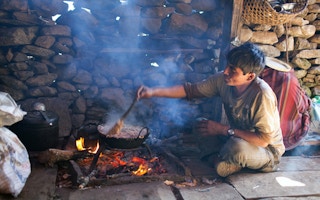They are called short-lived climate pollutants (SLCPs), but they play a significant role in global warming, as well as leading to serious health problems.
Although they exist for far shorter time spans in the atmosphere than CO2, the SLCPs can cause serious changes in climate in that time, particularly in urban areas or in highly climate-sensitive zones such as the polar regions and major mountain ranges.
The SLCPs − which include methane, black carbon or soot, and hydrofluorocarbons − are particularly prevalent in some of the world’s poorest regions.
Soot and fumes
Firewood, cow dung and other fuels, incompletely combusted on millions of household fires, give rise to high levels of SLCPs − as does the black soot and fumes belching from the exhaust pipes of hundreds of thousands of trucks and buses. The smoke and fumes originating from small industrial concerns, such as brick factories, also contain high levels of black carbon.
This pollution is swept by the winds up onto high mountain ranges, falling on the snow and glaciers and darkening the surface. Losing its ability to reflect the sun’s heat, the surface warms and a process of melting is set in motion.
“
Our work will contribute to the pathway of limiting global warming to 2˚C, harness health, food and energy benefits, and spur sustainable development.
Hanne Bjurstroem, Norway’s special envoy for climate change and a co-chair of CCAC
The Climate and Clean Air Coalition (CCAC) − initiated by the governments of Bangladesh, Canada, Ghana, Mexico, Sweden and the US, and the United Nations Environment Programme, and also comprising private sector groups and environmental organisations − was formed three years ago with the aim of curtailing SLCP emissions.
At a recent meeting in Kathmandu, the capital of Nepal, delegates were told that climate change was happening faster and in a dramatically more visible manner in the Earth’s cryosphere – the regions of ice and snow – than anywhere else on earth.
The consequences of increased melting in the Himalaya-Hindu Kush region are particularly serious.
According to the Kathmandu-based International Centre for Integrated Mountain Development, the area’s mountains store nearly 10 per cent of the world’s freshwater. And many millions of people across one of the planet’s most densely populated regions are dependent on mountain waters for agriculture and other purposes.
The CCAC is launching a series of schemes to combat SLCPs, including giving funds to city authorities for soot-free bus fleets and programmes to encourage less polluting agricultural practices.
“Our work will contribute to the pathway of limiting global warming to 2˚C, harness health, food and energy benefits, and spur sustainable development,” says Hanne Bjurstroem, Norway’s special envoy for climate change, and a co-chair of CCAC.
The SLCPs are also a serious health hazard. According to the World Health Organisation(WHO), more than four million people die prematurely each year as a result of household air pollution.
The WHO estimates that 2.8 billion people cook and heat their homes by burning coal and biomass – wood, dung, crop wastes and other solid fuels – on open fires or basic stoves.
Cancer-causing
Fumes from these fires contain minute levels of toxic substances, such as carbon monoxide, nitrous and sulphur dioxides and formaldehyde. They often also contain particles of cancer-causing substances that can penetrate deep into the lungs.
Women and children, who spend most time in the home, are particularly vulnerable. More than 50 per cent of premature deaths among children under five around the world, the WHO says, are due to pneumonia caused by particulate matter (soot) inhaled from household air pollution.
Solving the problem of SLCPs caused by household fires and other sources is not easy, but progress is being made in some areas.
In Nepal, the government says it is aiming for big cuts in SLCPs through various programmes, including the mass introduction of improved cooking stoves. The goal, it says, is to make Nepal free of indoor pollution by 2017.










